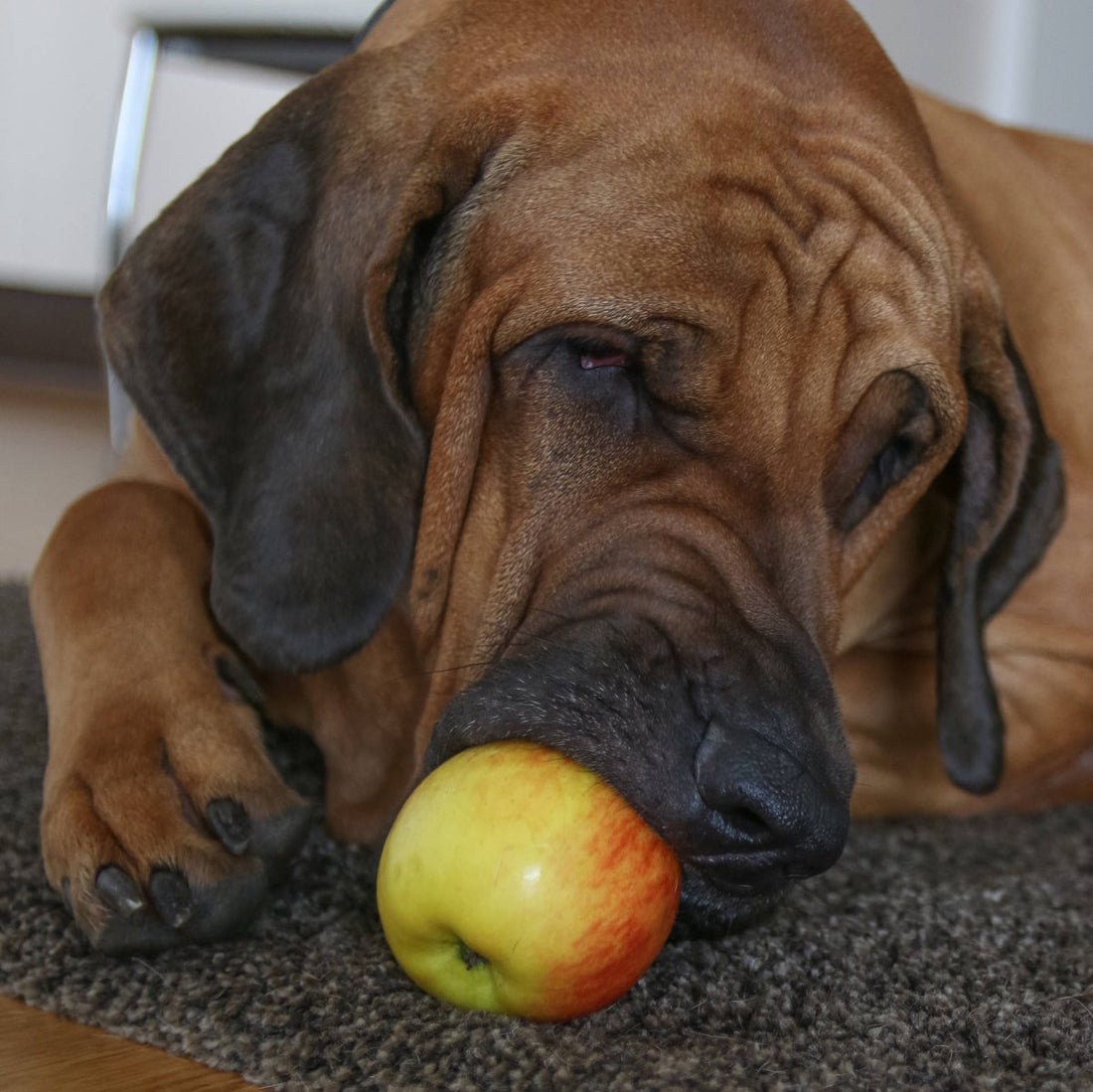Apples for dogs: Everything you need to know
Apples are one of the most popular fruits that almost everyone has at home. But can dogs eat apples? The short answer is yes! Apples are not only safe but also a healthy addition to your dog's diet. But as with anything, there are a few things to keep in mind. In this blog, you'll learn about the benefits of apples for dogs, how to prepare them properly, and what risks to avoid.
Can a dog eat apples? The answer is yes!
Dogs can eat apples, and in most cases, they're even a healthy addition to their diet. They contain important nutrients that can support your dog's well-being. However, not every preparation method is suitable, and there are some precautions you should keep in mind.
Why are apples good for dogs?
- They are rich in fiber, which aids digestion.
- Apples contain vitamins C and A, which strengthen the immune system.
- The high water content provides additional hydration.
- Apples are low in calories and therefore make a good healthy snack.
What are the benefits of apples for dogs?
1. Promotes digestion
Apples contain a lot of fiber, which helps regulate intestinal activity. Dogs with sensitive stomachs can especially benefit from a small apple snack.
2. Strengthening the immune system
Thanks to vitamin C and antioxidants, apples can strengthen your dog's immune system and make him more resistant to disease.
3. Healthy teeth
Chewing on apple pieces can help naturally clean your dog's teeth and reduce plaque.
4. Support weight regulation
Because apples are low in calories and fat-free, they are ideal for dogs who need to lose a few pounds or are prone to being overweight.
How do you properly prepare apples for your dog?
Preparing apples for dogs is easy, but there are a few things you should keep in mind to make the fruit safe:
1. Remove cores and casings
Apple seeds contain small amounts of cyanide, which can be harmful to dogs in large quantities. Therefore, always remove the core.
2. Cut into small pieces
Cut the apple into small, bite-sized pieces to avoid the risk of choking.
3. Leave the shell on or remove it?
Apple peel contains many nutrients, but it can also contain pesticides. If you're unsure whether the apple is untreated, peel it before feeding.
4. Serve fresh
Avoid sugary or processed apple products such as applesauce, as these are not suitable for dogs.
How often can a dog eat apples?
Apples should always be eaten in moderation. Although they are healthy, they contain fructose, which can cause digestive problems in large quantities.
Recommended amount:
- Small dogs: 1–2 small pieces per day.
- Medium-sized dogs: 2-4 small pieces.
- Large dogs: Half to one whole apple slice.
What are the risks of apples for dogs?
Although apples have many benefits, there are a few things you should be aware of to avoid accidentally harming your dog:
1. Apple cores and skins
As already mentioned, the kernels contain hydrogen cyanide. A small amount is not dangerous, but large amounts can be toxic.
2. Stomach problems
Dogs with sensitive stomachs may react to the fructose in apples. Start with small amounts to see how your dog reacts.
3. Danger of suffocation
Whole apples or large pieces can pose a choking hazard for small dogs.
4. Allergies
Although rare, some dogs can be allergic to apples. Watch for symptoms such as itching, vomiting, or diarrhea.
Which types of apples are suitable for dogs?
Dogs can eat almost all common apple varieties. However, there are some varieties that are more suitable due to their lower acid content:
- Golden Delicious: Mild taste, well tolerated.
- Gala: Sweet and juicy, ideal for dogs.
- Fuji: Less acidic, therefore gentle on the stomach.
Avoid very acidic varieties like Granny Smith if your dog is sensitive to acid.
Creative ideas: How can you incorporate apples into your dog's diet?
1. Apple snacks
Simply offer a few small pieces of apple as a reward or snack.
2. Homemade dog biscuits with apple
Bake healthy treats with apple, oatmeal and carrots for your four-legged friend.
3. Apple as filling
Fill toys like a Kong with pureed apple and yogurt to keep your dog busy.
4. Frozen apple pieces
Perfect for hot summer days – simply freeze apple pieces and serve as a refreshment.
Frequently asked questions about apples for dogs
“Can my dog eat apple peels?”
Yes, as long as the peel comes from untreated apples. Wash them thoroughly to remove pesticides.
“Can my dog drink apple juice?”
Fresh, unsweetened apple juice in small quantities is okay, but industrially processed products often contain sugar and are not suitable.
“Are green apples worse than red ones?”
Green apples contain more acid, which can cause problems for sensitive dogs. Red apples are therefore often a better choice.
Conclusion: Apple for dogs – healthy, but with caution
Apples are a great addition to your dog's diet, as long as you keep a few important points in mind. The most important facts at a glance:
- Benefits: Supports digestion, strengthens the immune system and promotes dental health.
- Preparation: Remove cores and peel, cut the apple into small pieces.
- Risks: Too many apples can cause stomach problems, and seeds should be avoided.
- Moderation: A few pieces a day are enough to do something good for your dog.
With these tips, you can give your dog a healthy and delicious treat – and maybe even enjoy an apple with him!



